Study of the Interaction of Dissolved Organic Carbon, Available Nutrients, and Clay Content Driving Soil Carbon Storage in the Rice Rotation Cropping System in Northern Thailand
Abstract
:1. Introduction
2. Materials and Methods
2.1. Study Area
2.2. Established Experimental Design
2.3. Soil Sample Collection
2.4. Soil Analysis
2.5. Data Management and Statistical Analysis
2.5.1. Calculating Organic Carbon Storage
2.5.2. The SOC/Clay Ratio
2.5.3. Statical Analysis
2.5.4. Intensity of Data Fertilization
3. Results
3.1. Effects of the RRCS on Carbon and Various Organic Carbon Fraction Concentrations
3.2. Effects of the RRCS on Chemical Properties
3.3. Effect of the RRCS on Soil Physical Property: Clay + Silt Contents, Soil Bulk Density (Bd), and SOC/Clay Ratio
3.4. Effects of the RRCS on Organic Carbon Storage
3.5. Relations of SOC and Labile Carbon and Soil Carbon Storage under the RRCS
Pearson’s Correlation between SOC Storage and Physicochemical Properties
3.6. Principal Component Analysis for Relations within Individual RRCSs
4. Discussion
4.1. SOC Adsorption by Soil as a Mineral-Associated Organic Carbon (MAOC) on the Formation and Decomposition of SOM
4.2. Soil and Crop Residue Influence on the DOC in Soils
4.3. Ability of Nutrients from the Fertilization of Labile Carbon Fractions to Form and Decompose SOC
4.3.1. Fertilization Practice
Nitrogen Fertilization
Phosphorus Fertilization
Cation Additions
4.3.2. Relationship between DOC, Availability of Nutrients, and the Priming Effect
4.4. Considering the SOC/Clay Ratio and Soil Carbon Saturation
5. Conclusions
Author Contributions
Funding
Informed Consent Statement
Data Availability Statement
Conflicts of Interest
References
- Poulton, P.; Johnston, J.; Macdonald, A.; White, R.; Powlson, D. Major limitations to achieving “4 per 1000” increases in soil organic carbon stock in temperate regions: Evidence from long-term experiments at Rothamsted Research, United Kingdom. Glob. Chang. Biol. 2018, 24, 2563–2584. [Google Scholar] [CrossRef] [PubMed] [Green Version]
- Jansson, J.K.; Hofmockel, K. Soil microbiomes and climate change. Nat. Rev. Microbiol. 2020, 18, 35–46. [Google Scholar] [CrossRef]
- Lal, R.; Delgado, J.A.; Groffman, P.M.; Millar, N.; Dell, C.; Rotz, A. Management to mitigate and adapt to climate change. J. Soil Water Conserv. 2011, 66, 276–285. [Google Scholar] [CrossRef] [Green Version]
- FAO. The State of the World’s Land and Water Resources for Food and Agriculture: Systems at Breaking Point; FAO: Rome, Italy, 2018; Available online: http://www.FAO.org (accessed on 12 June 2022).
- Hu, X.; Gu, H.; Liu, J.; Wei, D.; Zhu, P.; Cui, X.A.; Zhou, B.; Chen, X.; Jin, J.; Liu, X.; et al. Metagenomics reveals divergent functional profiles of soil carbon and nitrogen cycling under long-term addition of chemical and organic fertilizers in the black soil region. Geoderma 2022, 418, 115846. [Google Scholar] [CrossRef]
- Meena, S.K.; Rakshit, A.; Singh, H.B.; Meena, V.S. Effect of nitrogen levels and seed bio-priming on root infection, growth and yield attributes of wheat in varied soil type. Biocatal. Agric. Biotechnol. 2017, 12, 172–178. [Google Scholar] [CrossRef]
- Rajkishore, S.K.; Natarajan, S.K.; Manikandan, A.; Vignesh, N.; Balusamy, A. Carbon sequestration in rice soils. A review. Ecoscan 2015, 9, 427–433. Available online: https://www.researchgate.net/publication/281935281 (accessed on 6 September 2022).
- Gadde, B.; Bonnet, S.; Menke, C.; Garivai, S. Air pollutant emissions from rice straw open field burning in India, Thailand and the Philippines. Environ. Pollut. 2009, 157, 1554–1558. [Google Scholar] [CrossRef]
- Cheewaphongphan, P.; Garivait, S. Bottom up approach to estimate air pollution of rice residue open burning in Thailand. Asia-Pac. J. Atmos. Sci. 2013, 49, 139–149. [Google Scholar] [CrossRef]
- Aumtong, S.; Magid, J.; Bruun, S.; Neergaard, A. Relating soil carbon fractions to land use in sloping uplands in northern Thailand. Agric. Ecosyst. Environ. 2009, 131, 229–239. [Google Scholar] [CrossRef]
- Fujisaki, K.; Chapuis-Lardy, L.; Albrecht, A.; Razafimbelo, T.; Chotte, J.-L.; Chevallier, T. Data synthesis of carbon distribution in particle size fractions of tropical soils: Implications for soil carbon storage potential in croplands. Geoderma 2018, 313, 41–51. [Google Scholar] [CrossRef]
- Poeplau, C.; Zopf, D.; Greiner, B.; Geerts, R.; Korvaar, H.; Thumm, U.; Don, A.; Heidkamp, A.; Flessa, H. Why does mineral fertilization increase soil carbon stocks in temperate grasslands? Agric. Ecosyst. Environ. 2018, 265, 144–155. [Google Scholar] [CrossRef]
- Kleber, M.; Bourg, I.C.; Coward, E.K.; Hansel, C.M.; Myneni, S.C.B.; Nunan, N. Dynamic interactions at the mineral–organic matter interface. Nat. Rev. Earth Environ. 2021, 2, 402–421. [Google Scholar] [CrossRef]
- Córdova, S.C.; Olk, D.C.; Dietzel, R.N.; Mueller, K.E.; Archontouilis, S.V.; Castellano, M.J. Plant litter quality affects the accumulation rate, composition, and stability of mineral-associated soil organic matter. Soil Biol. Biochem. 2018, 125, 115–124. [Google Scholar] [CrossRef] [Green Version]
- Sanderman, J.; Baldock, J.A.; Amundson, R. Dissolved organic carbon chemistry and dynamics in contrasting forest and grassland soils. Biogeochemistry 2008, 89, 181–198. [Google Scholar] [CrossRef]
- Wu, L.; Xiao, Q.; Wang, J.; Huang, Y.; Wu, D.; Liu, J.; Wang, B.; Zhang, H.; Xu, M.; Zhang, W. Liming decreases the emission and temperature sensitivity of N2O following labile carbon addition. Geoderma 2022, 425, 116032. [Google Scholar] [CrossRef]
- Cui, J.; Zhu, Z.; Xu, X.; Liu, S.; Jones, D.L.; Kuzyakov, Y.; Shibistova, O.; Wu, J.; Ge, T. Carbon and nitrogen recycling from microbial necromass to cope with C:N stoichiometric imbalance by priming. Soil Biol. Biochem. 2020, 142, 107720. [Google Scholar] [CrossRef]
- Zhu, D.; Cong, R.; Ren, T.; Lu, Z.; Lu, J.; Li, X. Straw incorporation improved the adsorption of potassium by increasing the soil humic acid in macroaggregates. J. Environ. Manag. 2022, 310, 114665. [Google Scholar] [CrossRef]
- Zhang, Z.; Wang, J.; Huang, W.; Chen, J.; Wu, F.; Jia, Y.; Han, Y.; Wang, G.; Feng, L.; Li, X.; et al. Cover crops and N fertilization affect soil ammonia volatilization and N2O emission by regulating the soil labile carbon and nitrogen fractions. Agric. Ecosyst. Environ. 2022, 340, 108188. [Google Scholar] [CrossRef]
- Singh, M.; Sarkar, B.; Biswas, B.; Churchman, J.; Bolan, N.S. Adsorption-desorption behavior of dissolved organic carbon by soil clay fractions of varying mineralogy. Geoderma 2016, 280, 47–56. [Google Scholar] [CrossRef]
- Kuzyakov, Y. Priming effects: Interactions between living and dead organic matter. Soil Biol. Biochem. 2010, 42, 1363–1371. [Google Scholar] [CrossRef]
- Moore-Kucera, J.; Dick, R.P. PLFA Profiling of Microbial Community Structure and Seasonal Shifts in Soils of a Douglas-fir Chronosequence. Microb. Ecol. 2008, 55, 500–511. [Google Scholar] [CrossRef]
- Aitkenhead-Peterson, J.A.; Alexander, J.E.; Clair, T.A. Dissolved organic carbon and dissolved organic nitrogen export from forested watersheds in Nova Scotia: Identifying controlling factors. Glob. Biogeochem. Cycles 2005, 19. [Google Scholar] [CrossRef]
- Li, Z.; Wang, D.; Sui, P.; Long, P.; Yan, L.; Wang, X.; Yan, P.; Shen, Y.; Dai, H.; Yang, X.; et al. Effects of different agricultural organic wastes on soil GHG emissions: During a 4-year field measurement in the North China Plain. Waste Manag. 2018, 81, 202–210. [Google Scholar] [CrossRef]
- von Lützow, M.; Kögel-Knabner, I.; Ekschmitt, K.; Flessa, H.; Guggenberger, G.; Matzner, E.; Marschner, B. SOM fractionation methods: Relevance to functional pools and to stabilization mechanisms. Soil Biol. Biochem. 2007, 39, 2183–2207. [Google Scholar] [CrossRef]
- Fang, Y.; Singh, B.P.; Collins, D.; Li, B.; Zhu, J.; Tavakkoli, E. Nutrient supply enhanced wheat residue-carbon mineralization, microbial growth, and microbial carbon-use efficiency when residues were supplied at high rate in contrasting soils. Soil Biol. Biochem. 2018, 126, 168–178. [Google Scholar] [CrossRef]
- Nelson, D.W.; Sommer, L.E. Total Carbon, Organic Carbon and Organic Matter. In ASA-SSSA, Madison, Volume Methods of Soil Analysis, Part 2. Chemical and Microbiological Properties, 2nd ed.; American Society of Agronomy: Madison, WI, USA, 1983; pp. 579–595. [Google Scholar]
- Ghani, A.; Dexter, M.; Perrott, K.W. Hot-water extractable carbon in soils: A sensitive measurement for determining impacts of fertilisation, grazing and cultivation. Soil Biol. Biochem. 2003, 35, 1231–1243. [Google Scholar] [CrossRef]
- Weil, R.; Islam, K.R.; Stine, M.A.; Gruver, J.; Samson-Liebig, S. Estimate active carbon for soil quality assessment: A simplified method for laboratory and field use. Am. J. Altern. Agric. 2003, 18, 2–17. [Google Scholar]
- Murphy, J.; Riley, J.P. A modified single solution method for determination of phosphate in Natural water. Anal. Chim. Acta 1962, 27, 31–36. [Google Scholar] [CrossRef]
- Peech, M. Determination of exchangeable cation and exchange capacity of soil: Rapid micro methods ultilizing centrifuge and spectrophotometer. Soil Sci. 1945, 59, 25–28. [Google Scholar] [CrossRef]
- Gee, G.W.; Or, D. Particle-Size Analysis in Methods of Soil Analysis Part 4 Physical Methods; Dane, J.H., Topp, G.C., Eds.; Number 5 in the Soil Science Society of America Book Series; Soil Science Society of America, Inc.: Madison, WI, USA, 2002; pp. 255–293. [Google Scholar]
- Prout, J.M.; Shepherd, K.D.; McGrath, S.P.; Kirk, G.J.D.; Haefele, S.M. What is a good level of soil organic matter? An index based on organic carbon to clay ratio. Eur. J. Soil Sci. 2021, 72, 2493–2503. [Google Scholar] [CrossRef]
- Saidy, A.; Smernik, R.J.; Baldock, J.A.; Kaiser, K.; Sanderman, J.; Macdonald, L.M.; Macdonald, L.M. Effects of clay mineralogy and hydrous iron oxides on labile organic carbon stabilisation. Geoderma 2012, 173–174, 10–104. [Google Scholar] [CrossRef]
- Kaiser, K.; Guggenberger, G.; Zech, W. Sorption of DOM and DOM fractions to forest soils. Geoderma 1996, 74, 281–303. [Google Scholar] [CrossRef]
- Gmach, M.R.; Kaiser, K.; Cherubin, M.R.; Cerri, C.E.P.; Lisboa, I.P.; Vasconcelos, A.L.S.; Siqueira-Neto, M. Soil dissolved organic carbon responses to sugarcane straw removal. Soil Use Manag. 2021, 37, 126–137. [Google Scholar] [CrossRef]
- Lavallee, J.M.; Soong, J.L.; Cotrufo, M.F. Conceptualizing soil organic matter into particulate and mineral-associated forms to address global change in the 21st century. Glob. Chang. Biol. 2020, 26, 261–273. [Google Scholar] [CrossRef] [Green Version]
- Feng, X.; Simpson, M.J. Temperature responses of individual soil organic matter components. J. Geophys. Res. Biogeosci. 2008, 113. [Google Scholar] [CrossRef] [Green Version]
- Kaiser, K.; Guggenberger, G. The role of DOM sorption to mineral surfaces in the preservation of organic matter in soils. Org. Geochem. 2000, 31, 711–725. [Google Scholar] [CrossRef]
- Ussiri, D.A.N.; Johnson, C.E. Sorption of Organic Carbon Fractions by Spodosol Mineral Horizons. Soil Sci. Soc. Am. J. 2004, 68, 253–262. [Google Scholar] [CrossRef]
- Schneider, M.P.W.; Scheel, T.; Mikutta, R.; van Hees, P.; Kaiser, K.; Kalbitz, K. Sorptive stabilization of organic matter 85 by amorphous Al hydroxide. Geochim. Et Cosmochim. Acta 2010, 74, 19–1606. [Google Scholar] [CrossRef] [Green Version]
- Cotrufo, M.F.; Wallenstein, M.D.; Boot, C.M.; Denef, K.; Paul, E. The Microbial Efficiency-Matrix Stabilization (MEMS) framework integrates plant litter decomposition with soil organic matter stabilization: Do labile plant inputs form stable soil organic matter? Glob. Chang. Biol. 2013, 19, 988–995. [Google Scholar] [CrossRef] [Green Version]
- Swails, E.; Hergoualc’h, K.; Deng, J.; Frolking, S.; Novita, N. How can process-based modeling improve peat CO2 and N2O emission factors for oil palm plantations? Sci. Total Environ. 2022, 839, 156153. [Google Scholar] [CrossRef]
- Chen, M.; Chang, L.; Zhang, J.; Guo, F.; Vymazal, J.; He, Q.; Chen, Y. Global nitrogen input on wetland ecosystem: The driving mechanism of soil labile carbon and nitrogen on greenhouse gas emissions. Environ. Sci. Ecotechnol. 2020, 4, 100063. [Google Scholar] [CrossRef] [PubMed]
- Liu, S.P.; Chen, W.L.; Nie, X.T.; Zhang, H.C.; Dai, Q.G.; Huo, Z.Y.; Xu, K. Effect of embedding depth on decomposi-tion course of crop residues in rice-wheat system. J. Plant Nutr. Fertil. 2007, 13, 1049–1053. [Google Scholar]
- Jin, Z.; Shah, T.; Zhang, L.; Liu, H.; Peng, S.; Nie, L. Effect of straw returning on soil organic carbon in rice–wheat rotation system: A review. Food Energy Secur. 2020, 9, e200. [Google Scholar] [CrossRef]
- Matus, F.J. Fine silt and clay content is the main factor defining maximal C and N accumulations in soils: A meta-analysis. Sci. Rep. 2021, 11, 6438. [Google Scholar] [CrossRef] [PubMed]
- Zhou, J.; Wen, Y.; Shi, L.; Marshall, M.R.; Kuzyakov, Y.; Blagodatskaya, E.; Zang, H. Strong priming of soil organic matter induced by frequent input of labile carbon. Soil Biol. Biochem. 2021, 152, 108069. [Google Scholar] [CrossRef]
- Cotrufo, M.F.; Haddix, M.L.; Kroeger, M.E.; Stewart, C.E. The role of plant input physical-chemical properties, and microbial and soil chemical diversity on the formation of particulate and mineral-associated organic matter. Soil Biol. Biochem. 2022, 168, 108648. [Google Scholar] [CrossRef]
- de Catanzaro, J.B.; Beauchamp, E.G. The effect of some carbon substrates on denitrification rates and carbon utilization in soil. Biol. Fertil. Soils 1985, 1, 183–187. [Google Scholar] [CrossRef]
- Dung, T.V.; Thu, T.A.; Long, V.V.; Da, C.T. Decomposition of rice straw residues and the emission of CO2, CH4 under paddy rice and crop rotation in the Vietnamese Mekong Delta region—A microcosm study. Plant Soil Environ. 2022, 68, 29–35. [Google Scholar]
- Zhu, L.; Hu, N.; Zhang, Z.; Xu, J.; Tao, B.; Meng, Y. Short-term responses of soil organic carbon and carbon pool management index to different annual straw return rates in a rice–wheat cropping system. Catena 2015, 135, 283–289. [Google Scholar] [CrossRef]
- Ponizovsky, A.A.; Metzler, D.M.; Allen, H.E.; Ackerman, A.J. The effect of moisture content on the release of organic matter and copper to soil solutions. Geoderma 2006, 135, 204–215. [Google Scholar] [CrossRef]
- Kalbitz, K.; Solinger, S.; Park, J.H.; Michalzik, B.; Matzner, E. Controls on the dynamics of dissolved organic matter in soils. Soil Sci. 2000, 165, 207–304. [Google Scholar] [CrossRef]
- Li, Z.; Zhao, B.; Zhang, J. Effects of Maize Residue Quality and Soil Water Content on Soil Labile Organic Carbon Fractions and Microbial Properties. Pedosphere 2016, 26, 829–838. [Google Scholar] [CrossRef]
- Christ, M.J.; David, M.B. Temperature and moisture effects on the production of dissolved organic carbon in a Spodosol. Soil Biol. Biochem. 1996, 28, 1191–1199. [Google Scholar] [CrossRef]
- Aumtong, S.; Chotamonsak, C.; Somchit, B. The increased carbon storage by changes in adsorption capacity with a decrease of phosphorus availability in the organic paddy soil Ilmu Pertanian. Agric. Sci. 2022, 7, 91–98. [Google Scholar] [CrossRef]
- Wu, T.; Ost, A.D.; Audinot, J.-N.; Wiesmeier, M.; Wirtz, T.; Buegger, F.; Häusler, W.; Höschen, C.; Mueller, C.W. Association of fresh low-molecular-weight organic compounds with clay-sized mineral fraction in soils of different organic carbon loading. Geoderma 2022, 409, 115657. [Google Scholar] [CrossRef]
- Haque, M.M.; Biswas, J.C.; Salahin, M.; Alam, K.; Akhter, S.; Akhtar, S.; Maniruzzaman, M.; Hossain, M.S. Tillage systems influence on greenhouse gas emission factor and global warming potential under rice-mustard-rice cropping system. Arch. Agron. Soil Sci. 2022, 68, 1–16. [Google Scholar] [CrossRef]
- Yadvinder, S.; Bijay, S.; Ladha, J.K.; Khind, C.S.; Khera, T.S.; Bueno, C.S. Effects of Residue Decomposition on Productivity and Soil Fertility in Rice–Wheat Rotation. Soil Sci. Soc. Am. J. 2004, 68, 854–864. [Google Scholar] [CrossRef]
- Chen, J.; Xiao, W.; Zheng, C.; Zhu, B. Nitrogen addition has contrasting effects on particulate and mineral-associated soil organic carbon in a subtropical forest. Soil Biol. Biochem. 2020, 142, 107708. [Google Scholar] [CrossRef]
- Fontaine, S.; Mariotti, A.; Abbadie, L. The priming effect of organic matter: A question of microbial competition. Soil Biol. Biochem. 2003, 35, 837–843. [Google Scholar] [CrossRef]
- Marklein, A.R.; Houlton, B.Z. Nitrogen inputs accelerate phosphorus cycling rates across a wide variety of terrestrial ecosystems. New Phytol. 2012, 193, 696–704. [Google Scholar] [CrossRef]
- Zhang, Z.; Wang, X.; Liang, L.; Huang, E.; Tao, X. Phosphorus fertilization alters complexity of paddy soil dissolved organic. J. Integr. Agric. 2020, 19, 2301–2312. [Google Scholar] [CrossRef]
- Spohn, M.; Schleuss, P.M. Addition of inorganic phosphorus to soil leads to desorption of organic compounds and thus to increased soil respiration. Soil Biol. Biochem. 2019, 130, 220–226. [Google Scholar] [CrossRef]
- Spohn, M. Phosphorus and carbon in soil particle size fractions: A synthesis. Biogeochemistry 2020, 147, 225–242. [Google Scholar] [CrossRef] [Green Version]
- Uchida, Y.; Nishimura, S.; Akiyama, H. The relationship of water-soluble carbon and hot-water-soluble carbon with soil respiration in agricultural fields. Agric. Ecosyst. Environ. 2012, 156, 22–116. [Google Scholar] [CrossRef]
- Fisk, M.; Santangelo, S.; Minick, K. Carbon mineralization is promoted by phosphorus and reduced by nitrogen addition in the organic horizon of northern hardwood forests. Soil Biol. Biochem. 2015, 81, 212–218. [Google Scholar] [CrossRef]
- Scott, J.T.; Lambie, S.M.; Stevenson, B.A.; Schipper, L.A.; Parfitt, R.L.; McGill, A.C. Carbon and nitrogen leaching under high and low phosphate fertility pasture with increasing nitrogen inputs. Agric. Ecosyst. Environ. 2015, 202, 139–147. [Google Scholar] [CrossRef]
- Mganga, K.Z.; Kuzyakov, Y. Land use and fertilisation affect priming in tropical andosols. Eur. J. Soil Biol. 2018, 87, 9–16. [Google Scholar] [CrossRef]
- Jilling, A.; Keiluweit, M.; Contosta, A.R.; Frey, S.; Schimel, J.; Schnecker, J.; Smith, R.G.; Tiemann, L.; Grandy, A.S. Minerals in the rhizosphere: Overlooked mediators of soil nitrogen availability to plants and microbes. Biogeochemistry 2018, 139, 103–122. [Google Scholar] [CrossRef] [Green Version]
- McDonald, S.; Reid, N.; Waters, C.; Smith, R.; Hunter, J. Improving ground cover and landscape function in a semi-arid rangeland through alternative grazing management. Agric. Ecosyst. Environ. 2018, 268, 8–14. [Google Scholar] [CrossRef]
- Blagodatskaya, E.; Kuzyakov, Y. Mechanisms of real and apparent priming effects and their dependence on soil microbial biomass and community structure: Critical review. Biol. Fertil. Soils 2008, 45, 115–131. [Google Scholar] [CrossRef]
- Guo, X.; Wang, H.; Yu, Q.; Ahmad, N.; Li, J.; Wang, R.; Wang, X. Subsoiling and plowing rotation increase soil C and N storage and crop yield on a semiarid Loess Plateau. Soil Tillage Res. 2022, 221, 105413. [Google Scholar] [CrossRef]
- Feng, W.; Xu, M.; Fan, M.; Malhi, S.S.; Schoenau, J.J.; Six, J.; Plante, A.F. Testing for soil carbon saturation behavior in agricultural soils receiving long-term manure amendments. Can. J. Soil Sci. 2014, 94, 94–281. [Google Scholar] [CrossRef]
- Wilhelm, R.C.; Lynch, L.; Webster, T.M.; Schweizer, S.; Inagaki, T.M.; Tfaily, M.M.; Kukkadapu, R.; Hoeschen, C.; Buckley, D.H.; Lehmann, J. Susceptibility of new soil organic carbon to mineralization during dry-wet cycling in soils from contrasting ends of a precipitation gradient. Soil Biol. Biochem. 2022, 169, 108681. [Google Scholar] [CrossRef]
- Kleber, M.; Sollins, P.; Sutton, R. A conceptual model of organo-mineral interactions in soils: Self-assembly of organic molecular fragments into zonal structures on mineral surfaces. Biogeochemistry 2007, 85, 9–24. [Google Scholar] [CrossRef]
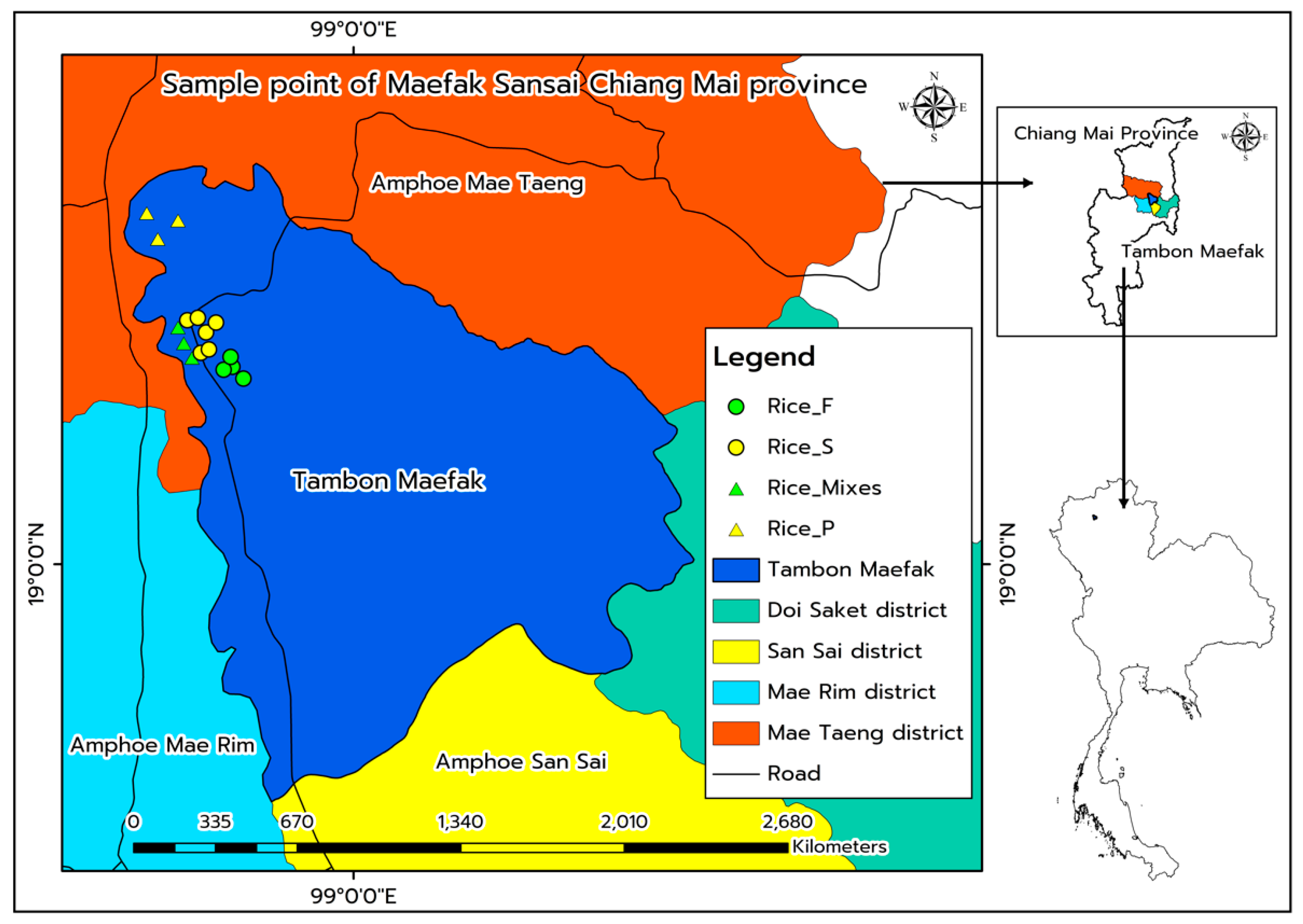


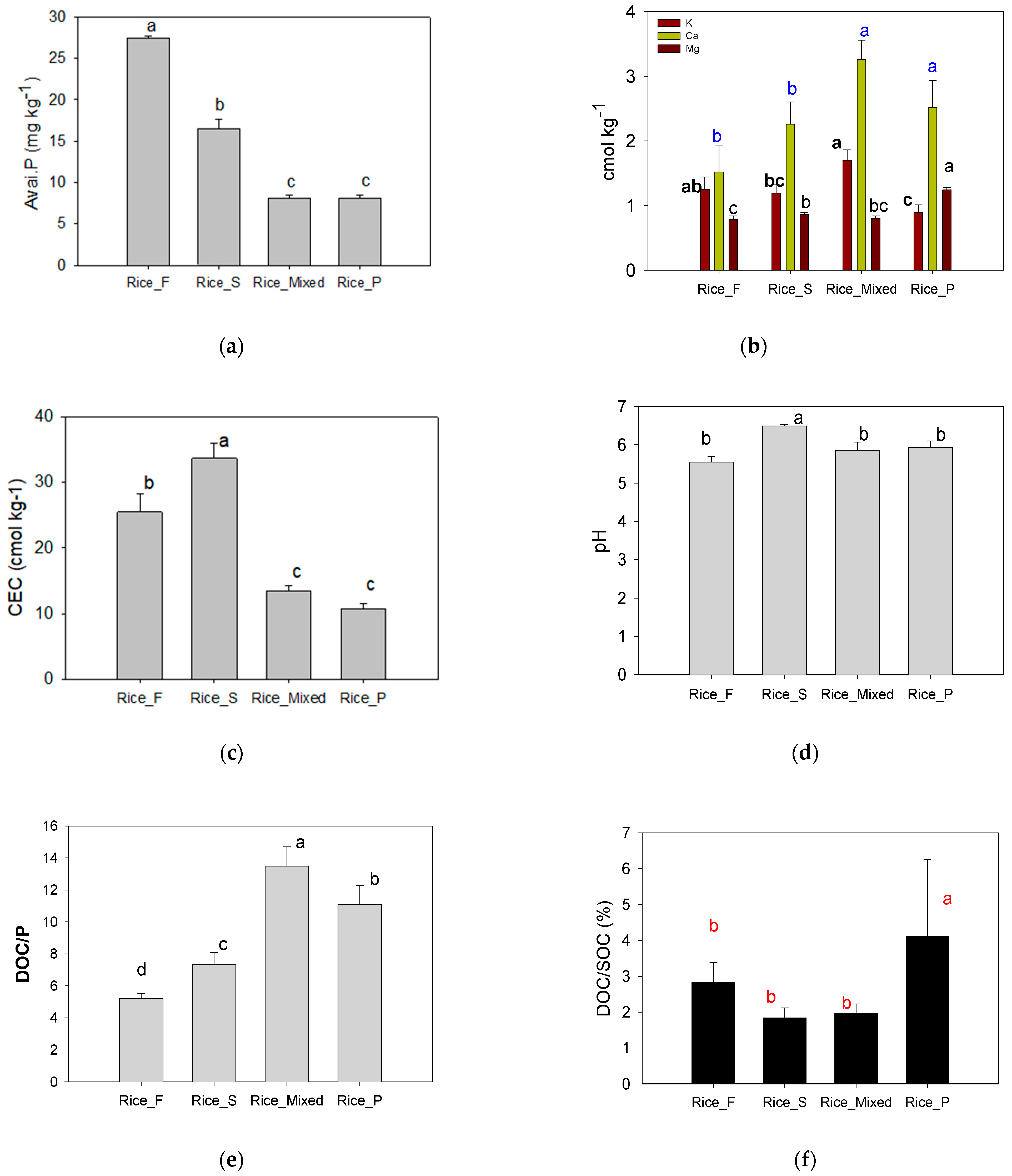
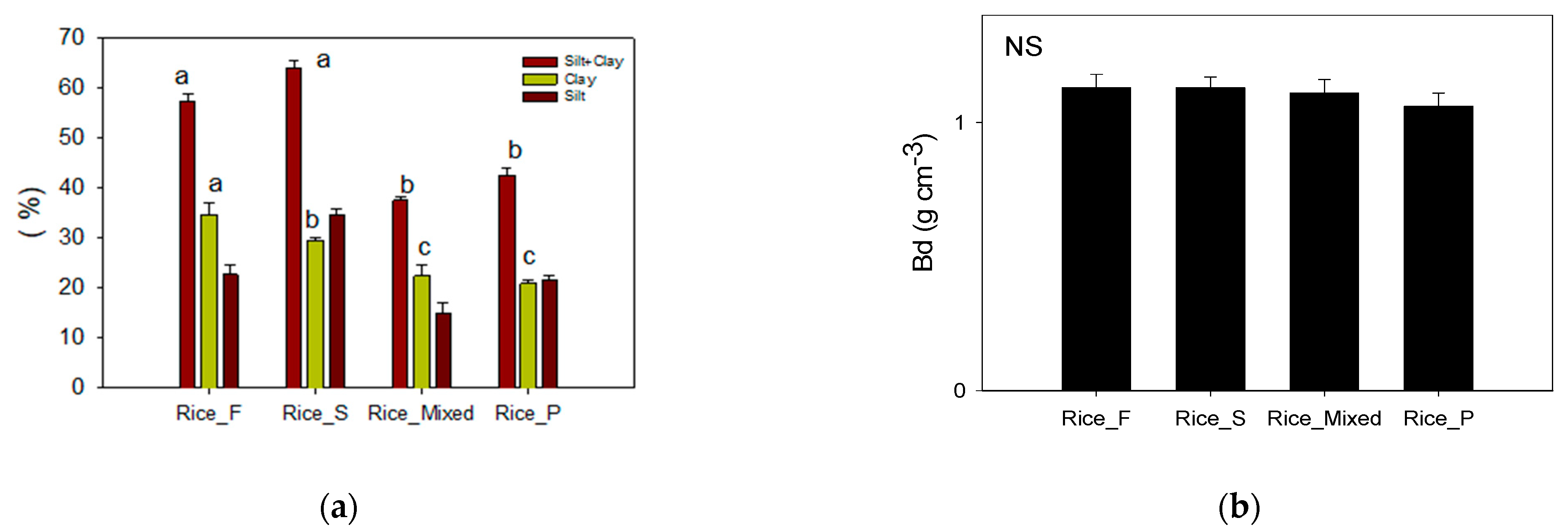
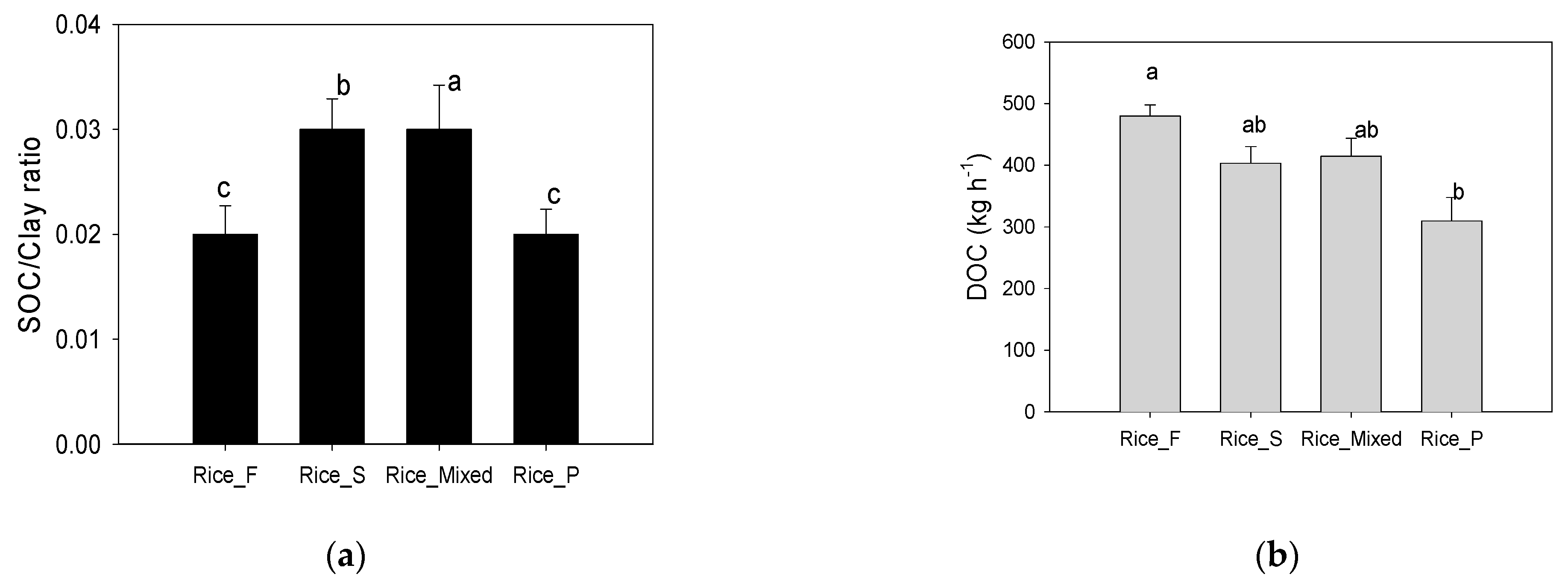
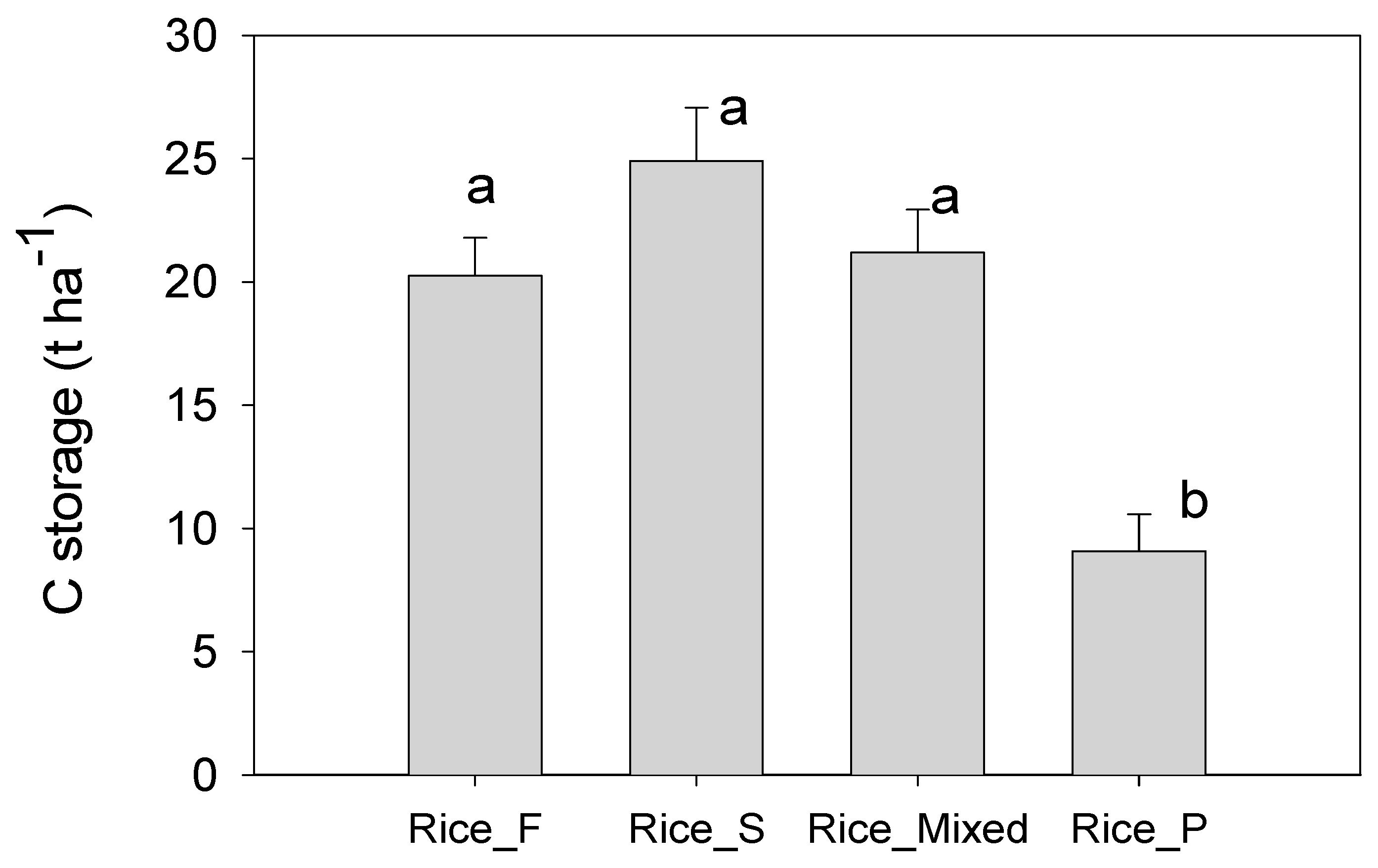


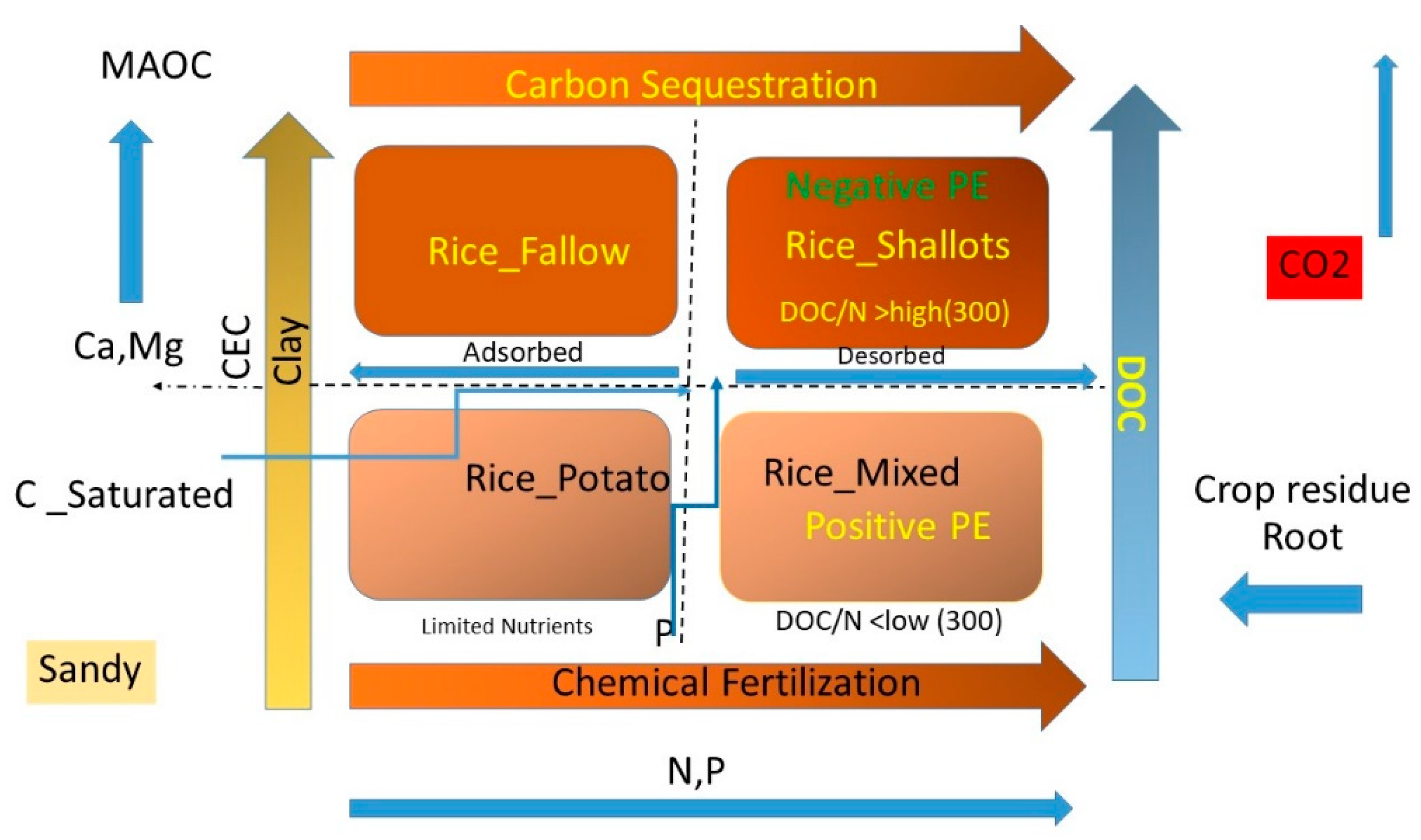
| Rice Rotation Pattern (RRCS) | Crop Residue Management | Starting Time of Land Use (Age) | Soil Preparation | |
|---|---|---|---|---|
| In-Season | Off-Season | |||
| Rice_F | Rice straw leaves are mulched on the soil surface until the next planting season when they are mixed in the soil. | 1998 (18 years) | First: moldboard plow Second: disk tiller Third: rotary tillage (3 times) | Fallow (no) |
| Rice_S | Rice straw and stubble are left after rice harvest. Soil preparation for shallot plantation includes covering the soil surface with these rice residues, which are incorporated into the soil just before shallots are planted. After the shallots are harvested, the soil is covered with some shallot leaves and fragments. These residues are incorporated into the soil before rice is planted. | 1967 (49 years) | Moldboard plow | |
| Rice_Mixed | After rice harvest, the leftover rice straw and stubble are mixed into the soil by tillage. Then, crops such as tobacco, maize, and cauliflower are planted. When these crops are harvested, the residues left in the field are mixed into the soil before rice is planted. | 1978 (38 years) | Rotary tillage, plow up | |
| Rice_P | Rice straw and stubble are left in the field after rice harvest. These are incorporated into the soil before potatoes are planted. After the potatoes are harvested, the leaves and trunks of potato fragments are left on the field. | 1989 (27 years) | Rotary tillage, plow up | |
| Rice Rotation Cropping System | Straw Retention and Returning | Tillage | Chemical Fertilization (kg ha−1 y−1) (N:P2O5:K2O:MgO) | Age (Year) |
|---|---|---|---|---|
| Rice_F | 2 | 1 | 180:10:10 | 1 (18), 1998 |
| Rice_S | 3 | 2 | 2128:29:29 | 3 (49), 1967 |
| Rice_Mixed | 2 | 3 | 3249:66:123 | 3 (38), 1978 |
| Rice_P | 1 | 3 | 365:10:55:33 | 2 (27), 1989 |
Disclaimer/Publisher’s Note: The statements, opinions and data contained in all publications are solely those of the individual author(s) and contributor(s) and not of MDPI and/or the editor(s). MDPI and/or the editor(s) disclaim responsibility for any injury to people or property resulting from any ideas, methods, instructions or products referred to in the content. |
© 2023 by the authors. Licensee MDPI, Basel, Switzerland. This article is an open access article distributed under the terms and conditions of the Creative Commons Attribution (CC BY) license (https://creativecommons.org/licenses/by/4.0/).
Share and Cite
Aumtong, S.; Chotamonsak, C.; Glomchinda, T. Study of the Interaction of Dissolved Organic Carbon, Available Nutrients, and Clay Content Driving Soil Carbon Storage in the Rice Rotation Cropping System in Northern Thailand. Agronomy 2023, 13, 142. https://doi.org/10.3390/agronomy13010142
Aumtong S, Chotamonsak C, Glomchinda T. Study of the Interaction of Dissolved Organic Carbon, Available Nutrients, and Clay Content Driving Soil Carbon Storage in the Rice Rotation Cropping System in Northern Thailand. Agronomy. 2023; 13(1):142. https://doi.org/10.3390/agronomy13010142
Chicago/Turabian StyleAumtong, Suphathida, Chakrit Chotamonsak, and Tantai Glomchinda. 2023. "Study of the Interaction of Dissolved Organic Carbon, Available Nutrients, and Clay Content Driving Soil Carbon Storage in the Rice Rotation Cropping System in Northern Thailand" Agronomy 13, no. 1: 142. https://doi.org/10.3390/agronomy13010142






